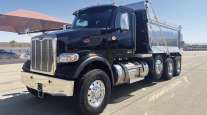Managing Editor, Features and Multimedia
Phase 2 Greenhouse-Gas Standards Being Developed with Market Transition in Mind, EPA Official Says

That proposal, focused on further reducing carbon emissions to address climate change, also will include trailer-efficiency standards for the first time, Bill Charmley, director of EPA’s assessments and standards division, said here March 24 at the ACT Research seminar.
He said EPA and the National Highway Traffic Safety Administration will publish a joint notice of proposed rulemaking later this spring — “hopefully by late May” — which will then provide an opportunity for the public to review the proposal and comment on it.
After analyzing that input, the agencies aim to issue a final rulemaking by March 2016, with implementation likely to begin around the 2020 timeframe, he said.
Charmley said the agencies are “quite certain” that the Phase 2 program will be proposing standards for new-build trailers, which weren’t included in the federal government’s initial greenhouse-gas rule.
The standards likely would apply only to on-highway trailers, with one category for dry van and reefer trailers and another for nonbox types, including flatbeds and bulk trailers, he said.
Charmely told Transport Topics that the implementation stages for trucks likely would begin around 2020 and continue to be phased in through 2025, or perhaps a year or two longer.
However, initial standards for 53-foot van trailers potentially could take effect earlier than 2020, he said.
The new proposal will follow the initial fuel-efficiency standards that started in 2014 and become more stringent in 2017 and 2018.
So far, the Phase 1 standards don’t seem to be having a negative effect on truck sales, Charmley said.
“That’s very promising from our perspective because we are certainly not ignorant of what happened in 2002 and in 2007,” he said. “We’d like to learn from the past and see if we can develop both the Phase 1 program and the Phase 2 program in a way that can work for the market and certainly not work against the market.”
Some of the emissions-reduction technologies adopted under prior rules, such as exhaust gas recirculation to lower nitrogen oxides and diesel particulate filters to cut particulate matter, did not provide operational benefits to customers but raised vehicle costs and, to a large extent, the initial product launches were “less than spectacular.”
With the greenhouse-gas standards, regulators will seek to provide “very long phase-in periods,” recognizing the research and market preparation needed by equipment makers to ensure a reliable launch.
The agencies are researching a variety of technologies, including engine down-speeding and down-sizing, improved transmissions and aerodynamics, automatic tire-inflation systems, low-rolling-resistance tires, speed limiters, weight reduction, diesel auxiliary power units and automatic engine shutdown.
However, the rule will use performance-based standards rather than dictating which specific technologies manufacturers will use to comply with the tighter requirements.




